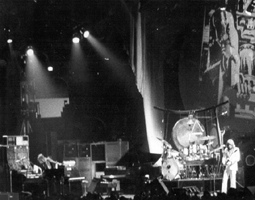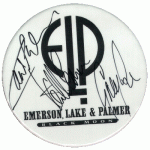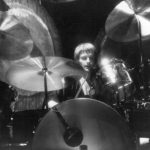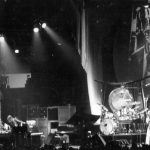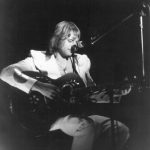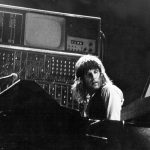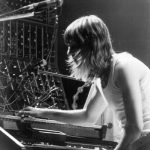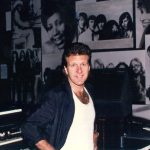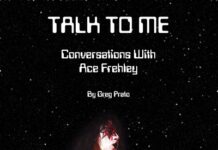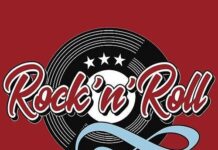By Shawn Perry
On September 9, 1998, Emerson, Lake & Palmer played their last show together. I was sitting four rows away from them, in the cozy confines of the 4th and B club in downtown San Diego, California. Seated next to me was a chap who claimed to be Keith Emerson’s best friend. Next to him was a woman who claimed to be Keith Emerson’s girlfriend. I told them I was Keith Emerson’s fan.
At the time, I don’t believe anyone knew this would be ELP’s final performance. They had been staggering in previous years, but tonight they seemed to be a little more on target. I’d heard they were working on a big conceptual piece that would serve as a throwback to the glory years – the 70s when ELP were at the top of their game, selling millions of records, packing arenas worldwide. If anything, I was led to believe that this would be their last show before such a small audience; that they would rocket back to the top by the new millenium, and reap the attention and appreciation I believe they so richly deserved. Ah, it was not meant to be.
It’s a damn shame when certain differences and disagreements emerge in such creative camps. It killed the Beatles. It killed the Marx Brothers. It’s bound to kill other creative units. That’s just what happens. ELP’s apparent problem is fairly minor when it’s taken for what it is: a disagreement over who would produce their next record. Greg Lake, who was credited with producing all of the band’s records during the 70s, wanted to return to the producer’s chair. Keith Emerson and Carl Palmer were not convinced. Despite the fact that their more recent records of the 90s have failed, both commercially and artistically when compared to their catalogue of the 70s, Emerson and Palmer believe a lot of that is to due to the sub-par efforts of Lake. The situation led to Lake’s departure, shortly after the show in San Diego.
Anyone who followed the band probably could have seen it coming. Lake’s voice wasn’t really as sharp and resonant as it had once been. But Emerson and Palmer were also not without fault. As a creative force, ELP had simply slid into a time when their music could not be as fully digested as it had been twenty-odd years before. Attention spans are not what they used to be. What’s worse, these guys were in their fifties, leading one to believe that the whole thing wreaked nostalgia. Perhaps they were sunk from the very beginning of their 1992 reunion. In the course of their run from ’92 to ’98, they went from headlining mid-size arenas to opening for Deep Purple and Jethro Tull – two other leftovers from the good old days who continue to endure despite their shrinking audience.
The San Diego gig was an off-show, a slight footnote that was thrown together following their last opening slot for Purple in L.A. Maybe they needed the extra cash. I managed to get some prime seats just by calling the 4th and B box office, and telling them I’d seen a special notice on the band’s web site. Apparently, there wasn’t much competition to get seats because I had only called a couple of days before the show. At this point, my interest in ELP had subsided and I wasn’t even sure I cared about going to see them.
On the day of the show, I was getting a little anxious. I checked in with the ELP web site just to get my juices going. I replied to a request for funny ELP stories. Even though they didn’t printed it, here is what it said:
“This is a tough one, because funny things have happened every time I’ve gone to an ELP concert. I first saw the band at the California Jam in 1974. At that time, I wasn’t very familiar with ELP; I was with my friend to see Black Sabbath and Deep Purple. After Deep Purple, my friend – who was also my ride – wanted to leave. I told him I wanted to see what ELP was all about. My friend said, ‘they’re nothing special. We have to leave NOW!’
“I insisted on getting my money’s worth and seeing ELP. ‘I’m staying and watching ELP.’ My friend looked me over and said. ‘Fine. Looks like you’re walking home.’ And off he went. I thought he was bluffing, but after a while I realized he actually left. Watching ELP that night, I was glad I stayed. They were the most incredible band I had ever seen. They have been my favorite ever since.”
But there was a price to pay. In 1974, I was only 15 years old and stranded in Ontario. I didn’t know a soul at the show, but managed to hitch a ride over to Riverside. I was broke, so I had to bum a dime off a waitress in a Denny’s restaurant to call my father. My father had already found out that my friend had left me behind and he had given him a firm tongue lashing – but he was even more upset with me. He finally picked me up at a street corner at around 7 AM the next morning. When we got home, I was grounded for a month.
When I was off restriction, I went out and bought Brain Salad Surgery. Within the next three months, I had all of Emerson, Lake and Palmer’s records.
Three years later, in 1977, I was out of high school and went on a trip across the United States. Every town I went to was getting pumped up for an ELP show.
“This is funny,” I said to my traveling companion, also an ELP fan. “We’re being followed by ELP.”
We saw the band in New York. When we returned to California, my girlfriend had already bought me a ticket for the ELP show at Long Beach Arena. Needless to say, I was ecstatic.
In 1988, I was backstage at the Atlantic Records 40th Anniversary at Madison Square Garden. I was working with Vanilla Fudge. It turns out that the Fudge were sharing a dressing room with Keith Emerson and Carl Palmer. Just as they were getting ready to go on, I snapped a cool picture of Emerson and got his autograph. They almost kicked me out their dressing room until I told them I was with Vanilla Fudge. I was bummed out that Greg Lake wasn’t there.
Over the years, I have crossed paths with ELP members, but I’ve always kept my distance. There have been NAMM shows where Emerson has appeared. There were club gigs that Emerson played in L.A., but I never got the chance to talk to Keith. In 1982, I met Carl Palmer when he was with Asia, and he started to flirt with my girlfriend. Another time, in 1992, a friend of mine was recording at Front Page Studios in Costa Mesa, and the engineer said ELP had just finished doing some sessions there. Two years ago, I spoke to Will Alexander about doing a profile of Keith, but it never panned out. I’d still like to write that piece. As a fan, I think it would do the man justice. Nevertheless, I maintain that Emerson, Lake and Palmer are such incredible musicians that it doesn’t matter if I meet them or not. I’m just thankful they’re together and making great music.
I’ll be keeping this in mind when I go see them tonight, for the 15th time, in San Diego.
Funny how I didn’t realize that this would be my last time to see who were once my favorite band. But when I heard about Lake’s departure and the eventual collapse of the band, I wasn’t surprised. For a band always ahead of their time, they were simply out of step with what was in store for the future. And I believe, in the end, the music will suffer because of it.
Recently, My memories of ELP were brought to light by a couple of separate incidents. First, I received a copy of Encores, Legends & Paradox (Magna Carta), a tribute album to the infamous prog-rock trio with a stellar cast. Along with veterans like John Wetton, Peter Banks, Geoff Downes and Martin Barre — the album is rounded out with the likes of Mark Bonilla, Mark Wood and Igor Khoroshev – younger musicians of the progressive fold. Within this collection, the arrangements and execution are of a different range, but the songs stand tall to their treatments. Proof in the pudding that, despite the technical resiliency of the material, ELP’s music is durable to a number of interpretations.
More recently, I heard that Keith Emerson was preparing to embark on a tour with Rick Wakeman (!), a keyboard rival in Yes during the 70’s. The opportunity to witness these two masters together is enough to revitalize my interest. So, I plunged through my archive of ELP photos, posted them, added a little text, and poof – here we are. C’est La Vie.


